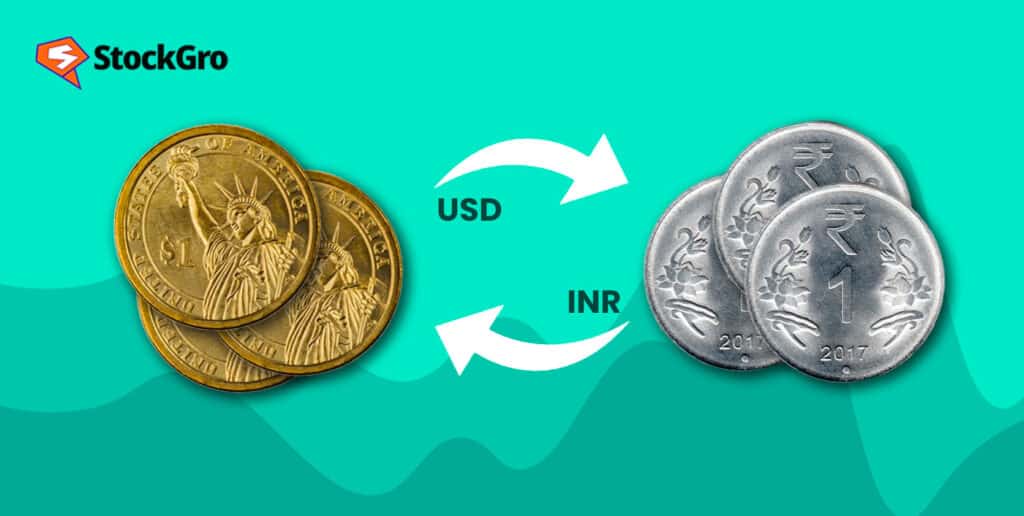
Forex trading, where you can buy or sell currencies, has become an increasingly popular avenue for investors seeking opportunities to make arbitrage profits. Amongst the 180 currencies that exist in the world, you could theoretically pick any two and make a trade between them. However, the USD-INR pair holds a special place, especially for traders interested in the Indian financial markets.
In this article, we will delve into the specifics of USD-INR trading, using it as a lens to explore key concepts of forex trading, and learning about some trading strategies too.
You may also like:
USD-INR trading pair
The USD-INR currency pair represents the exchange rate between the U.S. Dollar (USD) and the Indian Rupee (INR). This exchange rate is not only influenced by economic indicators of the United States and India but also by global events, geopolitical developments, and market sentiment.
The USD-INR pair has exhibited a long-term appreciation trend, with the USD generally gaining value against the INR. You can see this in this chart below.
In 2023, the USD-INR pair experienced huge volatility but currently, it has only appreciated by 0.5% over levels at the beginning of January.
Making USD-INR trades
Traders engaging in USD-INR transactions employ a multifaceted approach, integrating technical analysis, fundamental analysis, and comprehensive market research. Forex traders usually have to meticulously monitor pivotal economic indicators from both the United States and India, which include GDP growth, inflation rates, interest rates, and trade balances. In a high interest rate environment like today, these factors become more volatile and unpredictable, taking forex rates along for a ride.
Technical and fundamental factors are both important in their own ways. While fundamental metrics like economy numbers, Fed announcements, and other indicators can be more reliable in the long term, technical analysis is a great tool to maximise profits.
Also Read:
Fundamentally analysing the USD-INR pair
Here are some metrics that traders usually track when trading USD-INR forex.
- Economic strength: The overall health of the U.S. and Indian economies plays a major role in determining the exchange rate. Stronger economic growth often leads to a stronger currency, while weaker growth can cause it to depreciate.
- Inflation: Inflation, or the rate at which prices for goods and services rise, is another key factor. High inflation can weaken a currency, while low and stable inflation is generally considered positive.
- Interest rates: Interest rates set by central banks, such as the Federal Reserve in the U.S. and the Reserve Bank of India, also affect the exchange rate. Higher interest rates tend to attract foreign investment, which can strengthen the currency.
- Trade balances: The trade balance, or the difference between a country’s exports and imports, also matters. A positive trade balance (exports exceeding imports) can support the currency, while a negative balance can weaken it.
- Political stability: Political stability and geopolitical events can influence investor confidence and impact currency values. Uncertainties or tensions can lead to currency volatility.
- Forex reserves: The amount of foreign exchange reserves held by a country’s central bank can signal economic stability. Robust reserves can positively affect the currency’s value.
- Employment data: Strong employment data, such as low unemployment rates and job creation, is generally associated with economic prosperity and can strengthen the currency.
- Global economic conditions: Traders also consider broader global factors, such as global economic growth, financial market stability, and commodity prices, as these can impact risk sentiment and influence currency values.
Technical analysis for USD-INR
Savvy traders employ an array of technical indicators—such as moving averages, MACD, RSI, and Bollinger Bands—to gauge market momentum, identify overbought/oversold conditions, and pinpoint potential turning points in the forex market.
Here are some technical tips for when you’re trading forex in the USD-INR pair:
- Keep up with the news – Staying up to date with the news of the latest market developments is paramount to gauging and capitalising on movements. Professional traders access real-time news feeds, and analyses to make informed decisions based on current market conditions.
- Trade with discipline – Use stop losses, exit when you’ve hit your targets, and always diversify. Do not put all your eggs in one basket.
- Trading platforms and algorithmic trading bots – Forex trading, especially when trading for arbitrage, can be very stressful and sometimes even impossible for people to do by themselves. Special trading bots or algorithms are used to do background research, spot and execute trades, and make decisions in split-seconds. Familiarising yourself with these tools can help you save time and use your faculties in an optimum way.
Also Read:
Conclusion
USD-INR, hence, is a top trading pair if you want to get into trading forex. While forex trading can be lucrative for some people, retail traders almost always end up losing more money than they make in the long term. Make sure that you maximise your chances of making profits by diversifying well, doing your own research, and keeping up with everything you need to know to perform well. Good luck!

